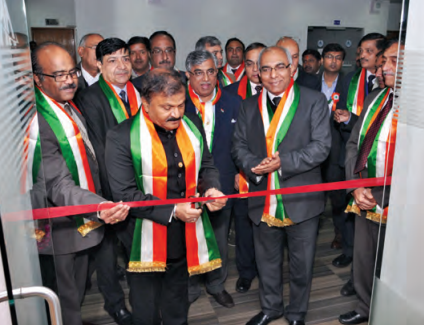Central Air Traffic Flow Management
AIBM
January-March 2017

Guruprasad Mohapatra, Chairman, AAI (centre) inaugurating Central Command Centre, Air Traffic Flow Management (CATFM) in the presence of AAI’s Board Members (from right) A K Dutta, Member (ANS), S Raheja, Member (Planning), I N Murthy, Member (Operations) (left) and other senior officers of AAI
Amongst the several initiatives that the Airports Authority of India is taking to upscale their services for better flying experiences, managing of air traffic is a crucial one. Recently, the authority deployed its air-traffic management system at airports across the country.
The Airports Authority of India (AAI) dedicated its ‘Central-Air Traffic Flow Management (C-ATFM)’ system to the nation on the occasion of the 68th Indian Republic Day on January 26, 2017. On the occasion, Guruprasad Mohapatra, Chairman, AAI, inaugurated the Central Command Centre, Air Traffic Flow Management at the New Air Traffic Services Complex in the presence the AAI’s board members, senior officers and representatives of airlines.
Speaking on the occasion, Mohapatra said, “India is on the threshold of becoming the seventh country in the world to implement the Air Traffic Flow Control Measures across the nation, which will accrue benefits in terms of reduced carbon foot print, embarking on a green environment concept, fuel savings and economic benefits for the air travellers.”
The AAI is in the process of implementing C-ATFM system covering the entire Indian airspace and major airports, to begin with, and subsequently applying it nationwide.
The C-ATFM system is primarily meant to address the balancing of capacity against the demand, to achieve optimum utilisation of the major resources that include ground premises, airspace and aircrafts at every Indian airport where there is a capacity constraint. The ATFM service relies on a number of supporting systems, processes and operational data, which are already in place for efficient management of air traffic flow across the country.
The system displays weather information along with static information about airports, airspaces and air routes. It processes the demand and capacity information, provides decision making tools to the ATF managers for collaborative decision making in consultation with airlines, military and airports operators to facilitate the regulated flow of traffic in each airport in India.
With the introduction of ATFM in India, it is envisaged to create enhanced safety, facilitate cost savings to airlines, resulting out-of-fuel savings approximately to the tune of INR 16.80 billion per year, enable reduction in operating cost for airlines and contribute to green environment.









